Whether you’re a Tony Robbins fan or a Tony Robbins skeptic, with over one million website visitors per month you can’t deny he’s done well for himself online.
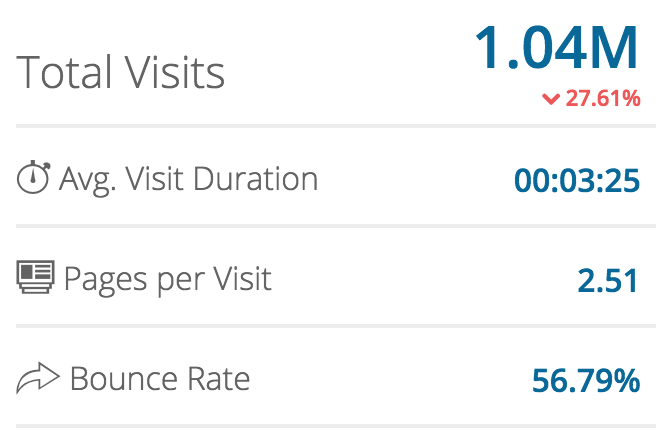
Today I’m going to show you exactly how Tony Robbins has grown his website traffic to over one million website visitors per month so you can copy this EXACT strategy to grow your own traffic.
Table of Contents
%(tableofcontents)
Tony Robbins is a force of nature. Seriously, look at what a Google search for his name brings up:
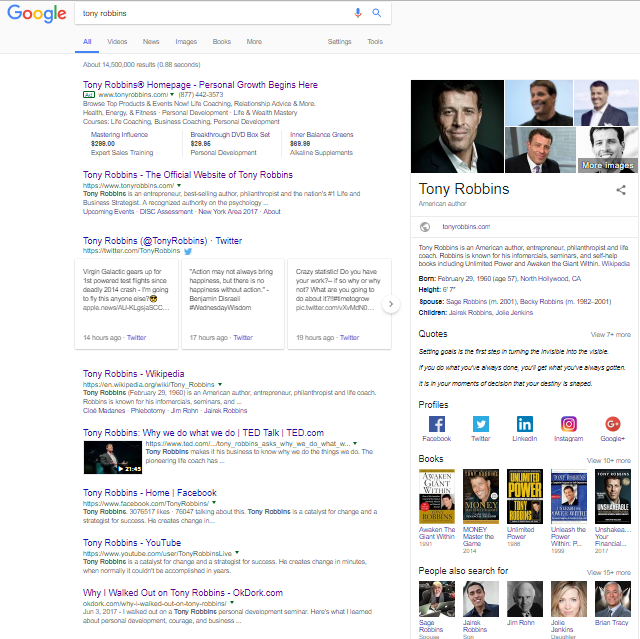
Chances are, you already know who he is. But if you don’t…
- He is one of the most well-known "why guys" and life coaches in the world.
- He’s sold 15 million copies of his books and 50 million copies of his audio programs worldwide.
- His net worth is half a billion.
- His loyal fans (happily) pay thousands just for the privilege of being in the same room as him for a few days.
- He’s rubbed shoulders with and coached some impressive names – from former presidents like Bill Clinton, sports superstars like Andre Agassi, and billion dollar tech influencers like Salesforce CEO Marc Benioff.
Clearly, he’s doing something right.
But let’s be realistic. Very few (if any) of us will ever hit the worldwide recognition, renown and success Tony has. Which might make you wonder if you’ll get anything useful from reading how he markets himself.
After all, most of Tony’s traffic comes from his personal brand. Tony likes it 95% organic… just like his eggs.
But what most people don’t realize is that organic and paid traffic is only 39% of Tony’s total traffic.
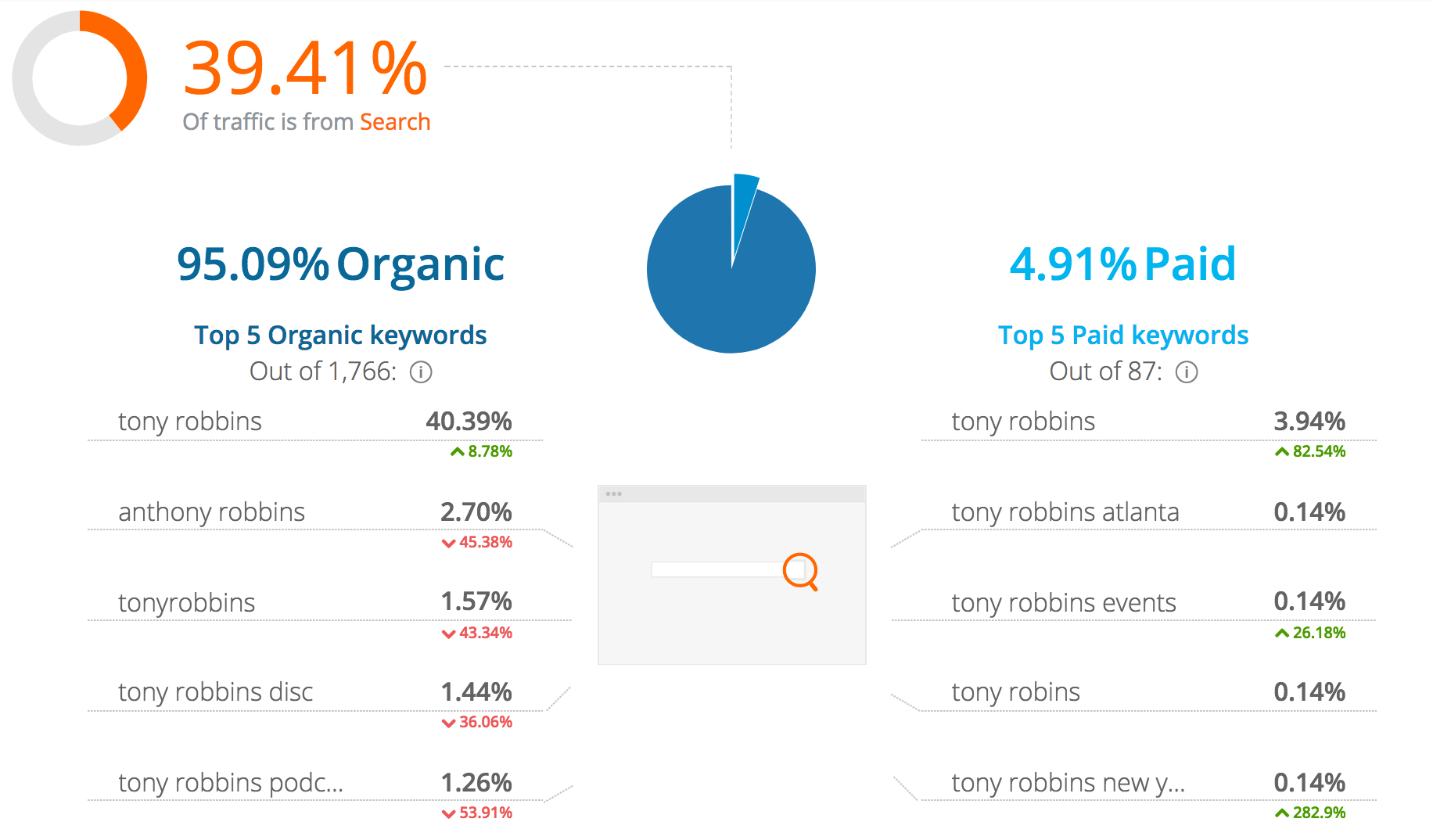
The rest comes from advanced marketing tactics Tony and his team use to build a multi-million dollar online business around the Tony Robbins brand.
Ready to see em’?
Let's go.
[Tip #1] The AIDA Lead Generation Quiz That Can Double Your Product Sales In The Next 3 Months: “AIDA Formula” Plus Simple Score-Based Email Segmentation
The primary call-to-action on Tony Robbins’ homepage is “TAKE OUR FREE LIFE ASSESSMENT.”
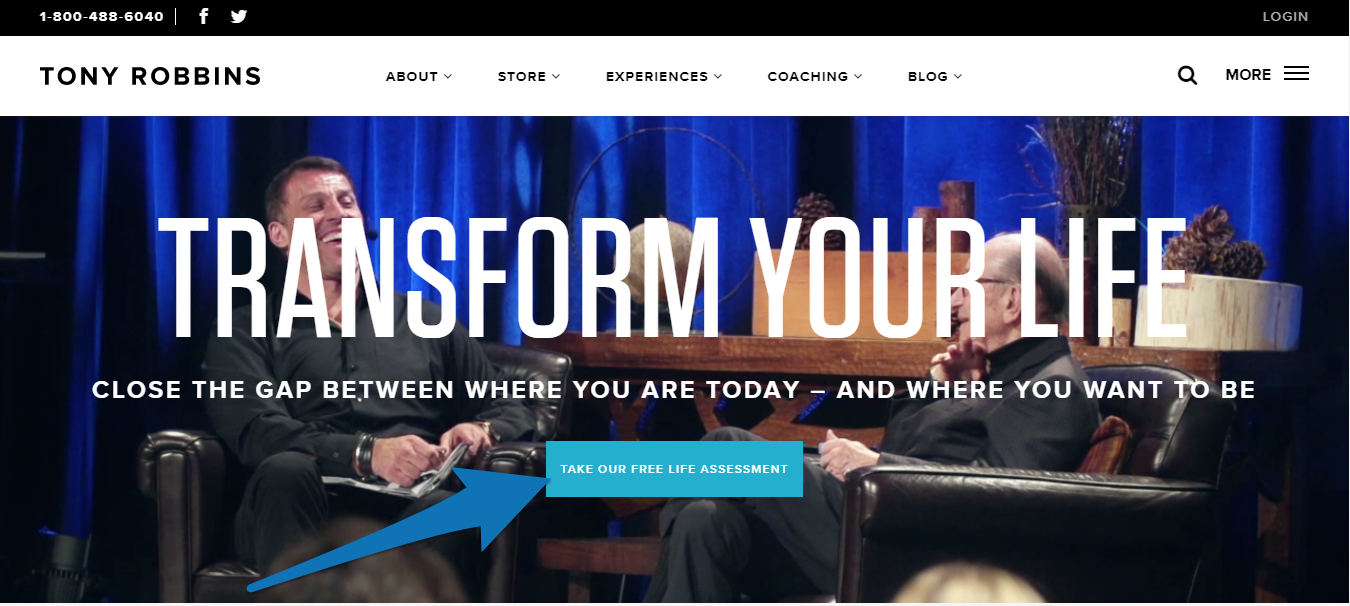
This blue button links directly to Tony’s “Wheel of Life” Quiz and is a brilliant way to start off his page.
Instead of instantly pushing products or giving another boring “click here” CTA, it gives prospects a you-centric offer via a lead generation quiz.
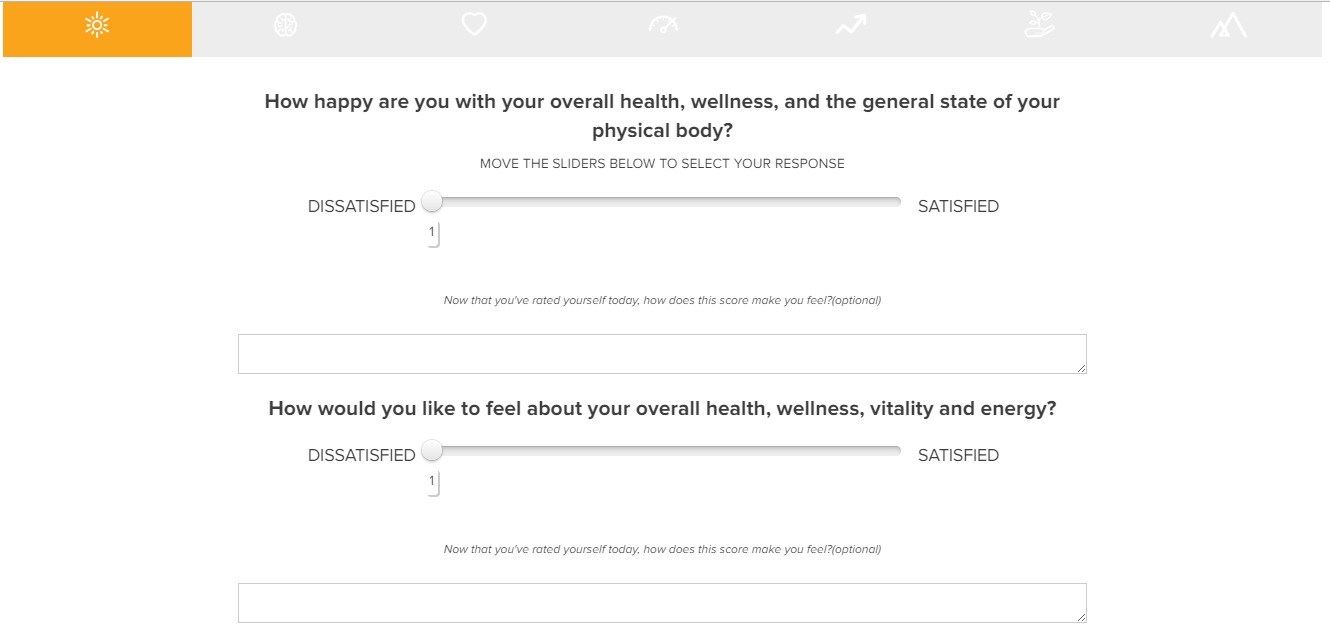
It also appeals to a wide audience – whether hot, cold, or anywhere in between. Finding out how you can ‘improve your life’ is a universal curiosity.
But this isn’t a clever CTA just because it entices you to click. You also have to look at the content of the quiz.
It encourages quiz-takers to take a hard look at their lives and look for areas that could be improved.
The quiz has the same two questions for 7 different “Wheel of Life” categories (which all happen to be areas that Tony has products in).
Note how Tony uses a slider for people to rate themselves. This makes it easy for mobile visitors to complete the quiz by sliding their finger on their screen.

We have a CTA that’s not only great at enticing a wide range of audience members to click, but also agitates their pain points and reminds them of reasons why they might seek out Tony in the first place.
And once you’ve completed the quiz, Tony’s marketing team knows better than to go straight for the hard sell.
First, you're offered an insight into your ‘gap’ percentage (the difference in where you are now and where you want to be in life)…which just pokes that pain yet again.

Instead of selling, you’re given the option to “SPEAK TO A PERSONAL RESULTS SPECIALIST” about the “problems” you’ve just discovered and agitated through the quiz.
This entire sequence is marketing at its finest using the age-old AIDA direct response marketing formula:
Attention: Tony grabs attention with his “Wheel of Life” quiz
Interest: Tony gets people interested with a series of strategic, probing questions
Desire: Tony gives people their own Gap score and the desire to improve it (who doesn’t want get to 100%, right?)
Action: Tony makes an offer to speak to one of his personal results specialists to strengthen their weakest areas
It gets even better though. This quiz gives Tony and his team a way to segment their email list based on ratings quiz-takers give for different aspects of their lives.
Tony and his team can then deliver the most relatable, relevant, and interesting content to each segment.
Here’s what that looks like: for the sake of the experiment, I gave myself a low score in both the ‘Health & Vitality’ as well as the ‘Leadership & Impact’ categories.
Unsurprisingly, these were the first two categories I received emails about post-test:

The emails all follow the same format. First, they offer a link to a useful piece of content based on my quiz results, and then made a call-to-action to speak to a personal results specialist.
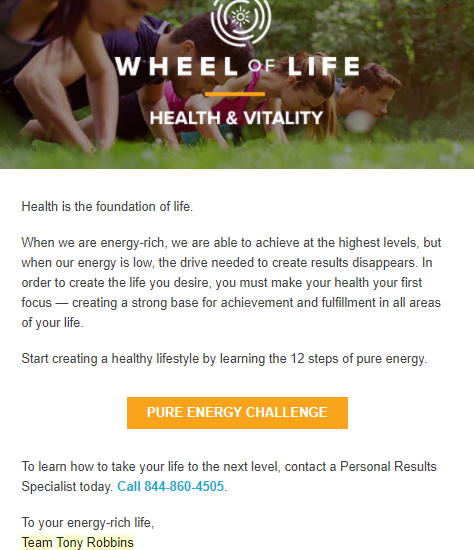
The takeaway: Use a lead generation quiz at the top of your funnel to capture your website visitors’ contact information and segment them into categories based on their responses. Tony has 7 categories (health & vitality, mind & meaning, love & relationships, productivity & performance, career & business, wealth & lifestyle, leadership & impact).
You can do the same for your business based on the different products your business sells.
Click here to reveal the lead generation quiz tool Tony uses.
[Tip #2] The “VAKAD Learning Style” Homepage Design That Converts Website Visitors Into New Product Sales With Low-Commitment CTAs
You've seen what’s happening above-the-fold on Tony’s homepage, but let’s look at what happens as we move further down the homepage.

You see all those circles? Those are all CTAs.
10 CTAs to be exact.
Most businesses would shy away from putting that many CTAs on a single page, believing them to be a distraction. In my analysis of Slack’s growth strategy, I found just one simple CTA.
So, how does Tony get away with having so many?
There are two aspects to Tony’s website that allow this:
- The number of products Tony offers
- A wide-ranging audience that comes to Tony’s website in varying stages of awareness.
Including so many CTAs gives Tony the chance to appeal to many different types of people all looking for different things.
Also note the amount of free offerings and access to valuable info these CTAs give, and how carefully ordered they are.
First, we have the above-the-fold section with “TAKE OUR FREE LIFE ASSESSMENT” as Tony’s primary CTA.
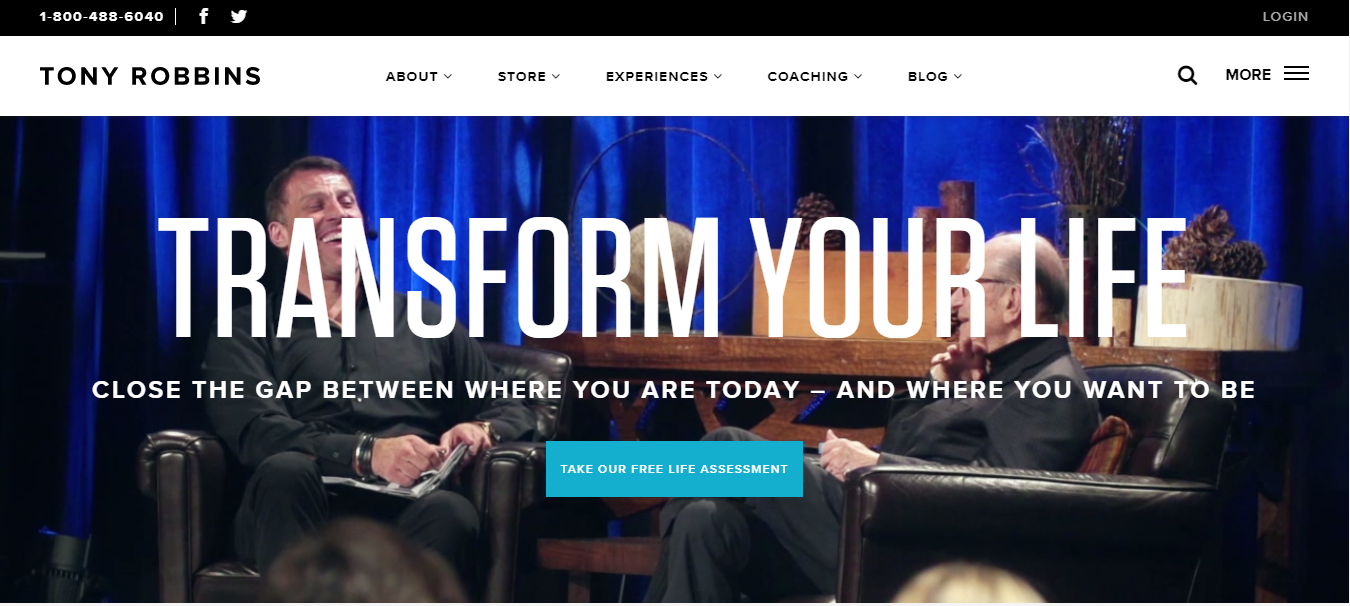
Next up, is a CTA for “SCHEDULE YOUR CALL".

Getting someone on a live call is a great way to convert. But making a phone call the primary CTA is not only a bit aggressive, but also asking them to make a time and energy commitment.
This is precisely why the current ‘life quiz’ button fits in perfectly as the primary CTA (it calls for an easy and low-commitment action) and the ‘schedule your call’ button fits in best as a secondary CTA.
Continuing on, you’ll find several CTAs asking readers to “LEARN MORE” about making improvement in either their professional or personal life (we’ll talk about what happens when you click these links in the next tip).
This is the lowest-commitment CTA on the page.

Next up is a CTA to read more about Tony.

Since Tony is selling his personal brand just as much as his products, it makes sense that he gives readers a venue to learn more about him.
Take note of the sticky scroll bar at the bottom of the page for Tony’s social media accounts and newsletter. This bar doesn't show up until you hit this ‘About’ section while you scroll. By not having this bar follow readers from the very top, grabs attention more effectively, and isn’t introduced until the reader’s awareness of Tony has been increased.
Next up is a CTA to “Read Maria’s story”, and stories of other famous people who have had success with Tony:
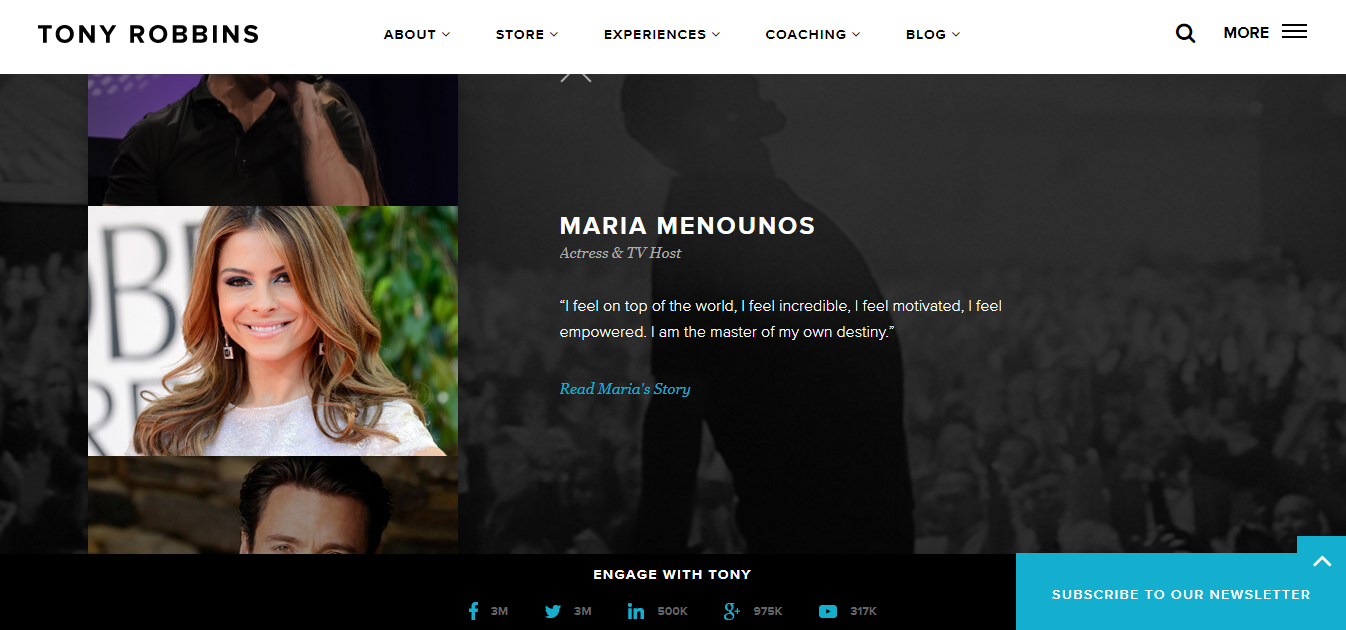
Tony knows how to leverage his ‘social proof’ (and is a guy that name-drops quite often… just ask Noah).
But dumping all your social proof on one page is distracting. So he gives readers the option to click and learn more if that case study resonates with them.
After the social proof section, Tony has a “LEARN MORE” CTA for a free app that many of Tony’s audience members would likely find useful:
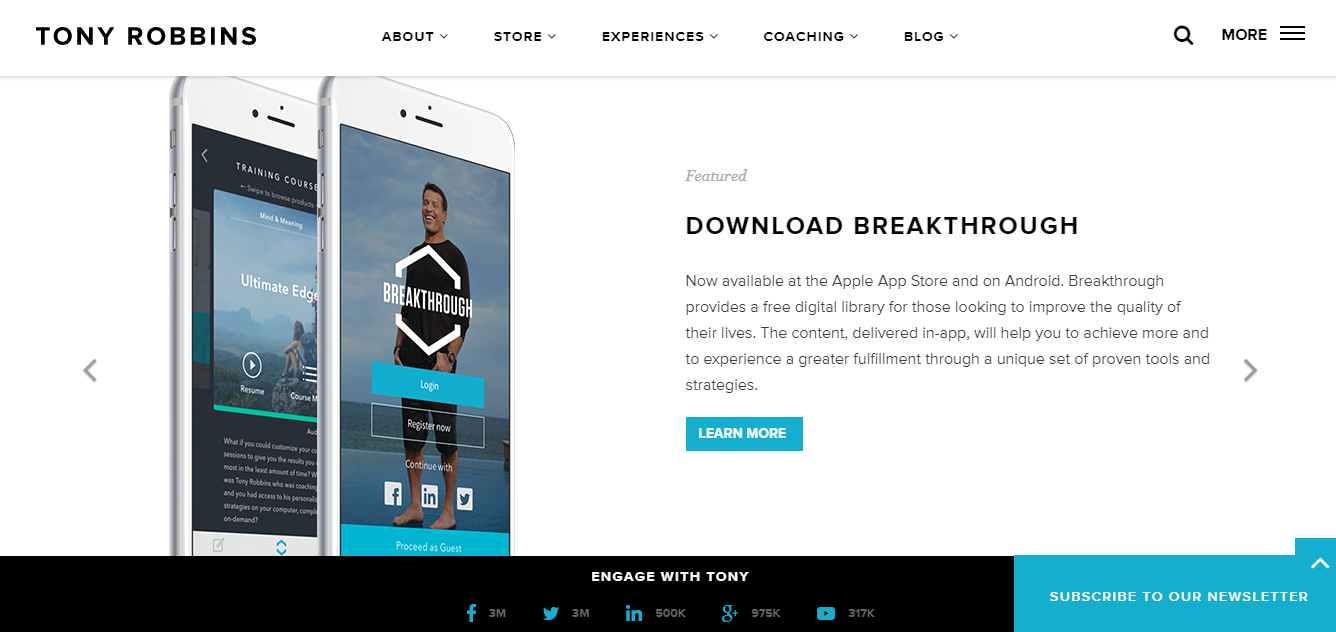
This app is just one part of Tony’s content marketing strategy that helps nudge prospects toward buying by:
- Giving them an offer that’s easy to say “yes” to
- Providing the audience with free value which they can access anytime when they are on-the-go via their mobile (which in turn builds up their trust and confidence in Tony and his products)
- Presenting the audience with a ‘taste’ of what working with Tony could be like
The next two sections aren’t explicit CTAs, but a promotion of Tony’s blog and video content. They serve the same purpose as Tony’s app in that they offer readers access to free, useful content:

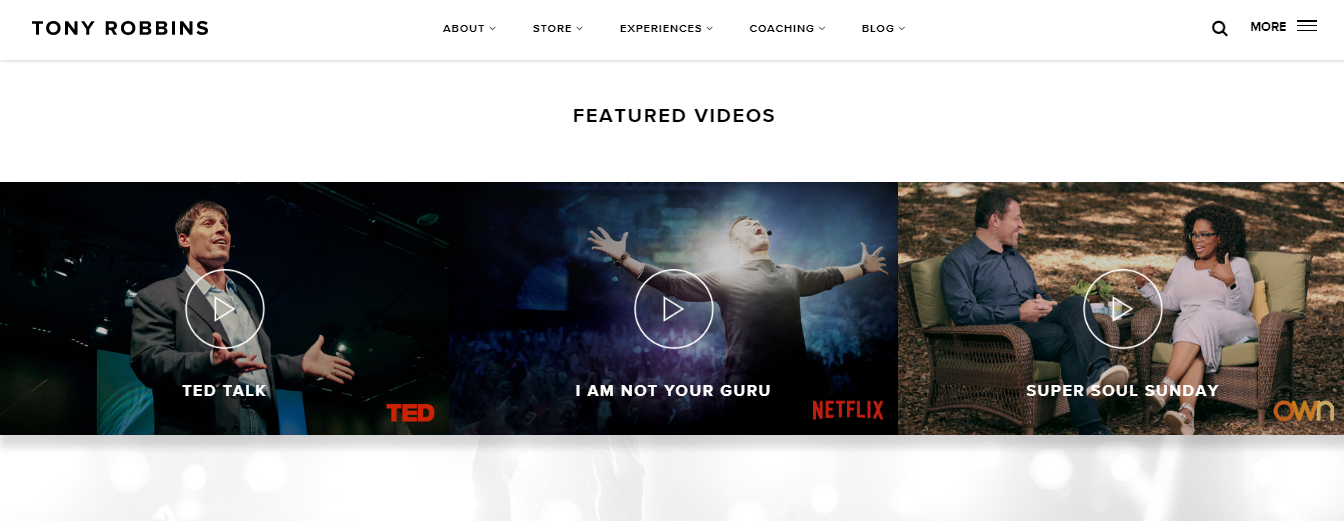
Golden Nugget: Note how Tony’s blog post categories are divided into the same categories that make up the quiz in tip #1.
This isn’t an accident. Tony is sending category-specific content to nurture his leads, based on their scores from his quiz. #genius
We move onto Tony’s ‘big sell’: “RESERVE YOUR SEAT” in one of his seminars:
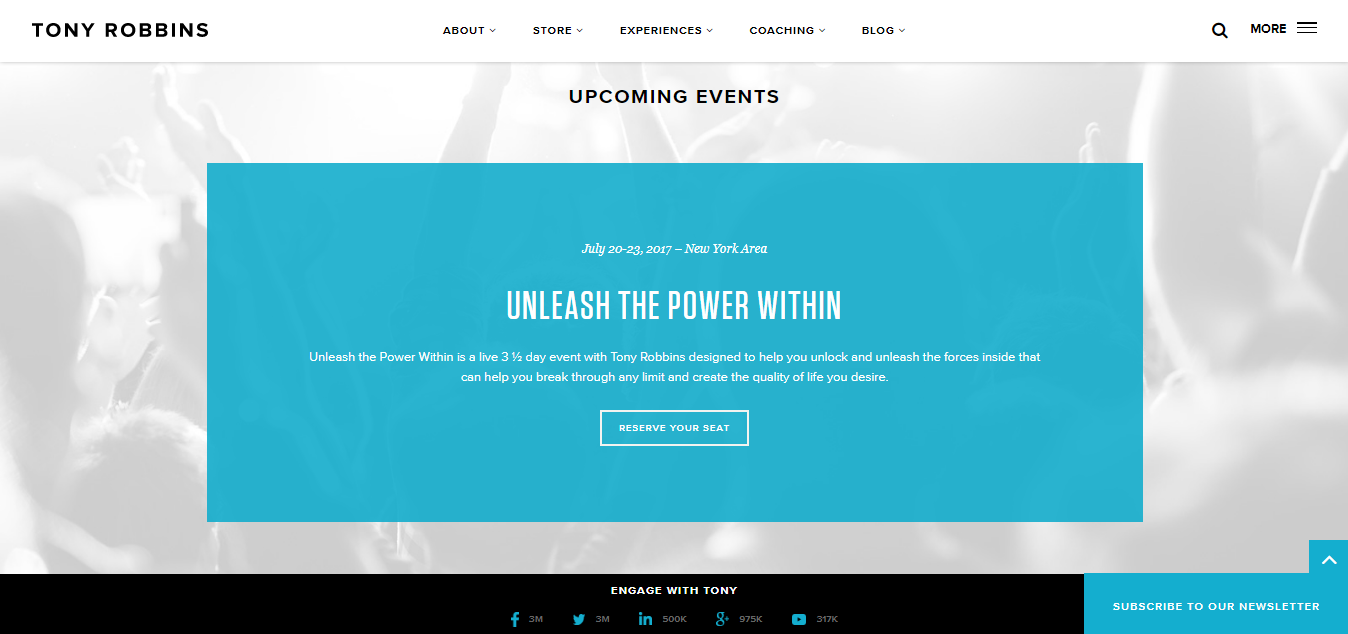
This is the first time any mention of a product appears on Tony’s homepage. But, if this is the action Tony really wants people to take, why not put it at the top front and center?
Keeping his big offer lower on the page will mean the prospect has to scroll past all the other stuff first. This then gives the prospect a chance to learn more, read social proof and build confidence and trust in Tony and his products.
This particular CTA is also sandwiched between two free content offerings – the blog/videos and the podcast. This takes the edge off the sales angle.
We now switch back to yet another free content CTA with “LISTEN TO THE PODCAST”. This is yet another way for Tony to use content to connect with people:
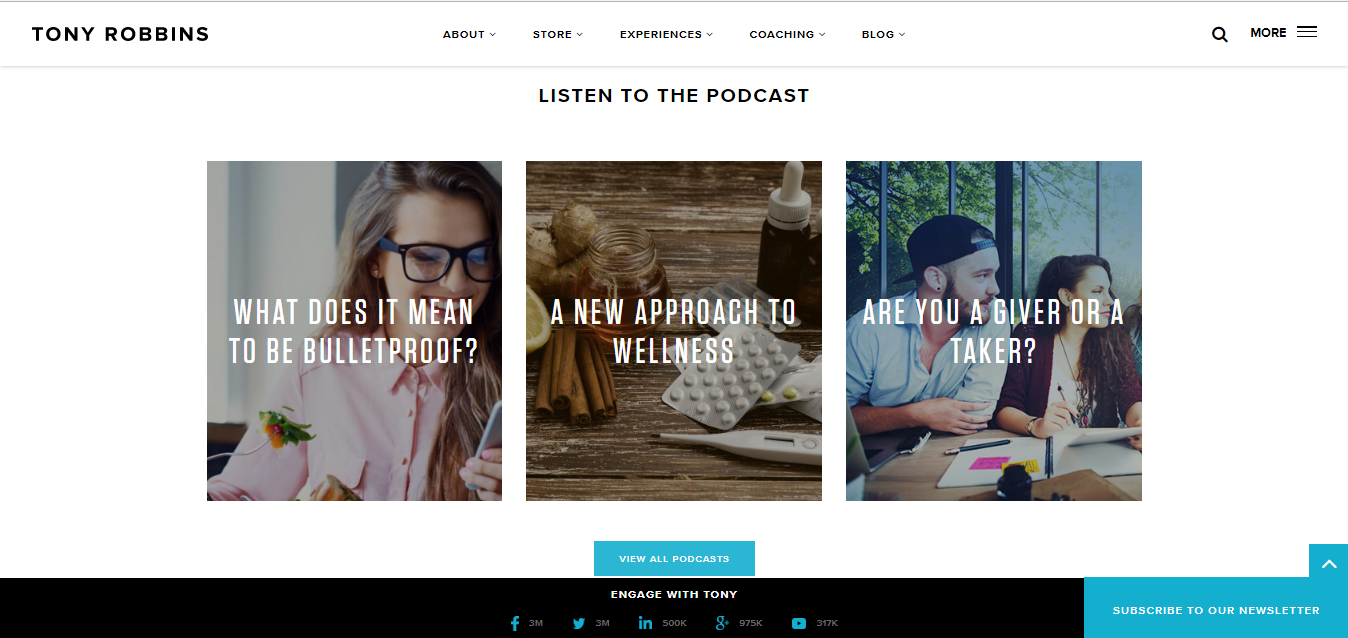
Our next up is not a CTA, but instead a quick presentation of what is called “TONY’S EXTENDED FAMILY":
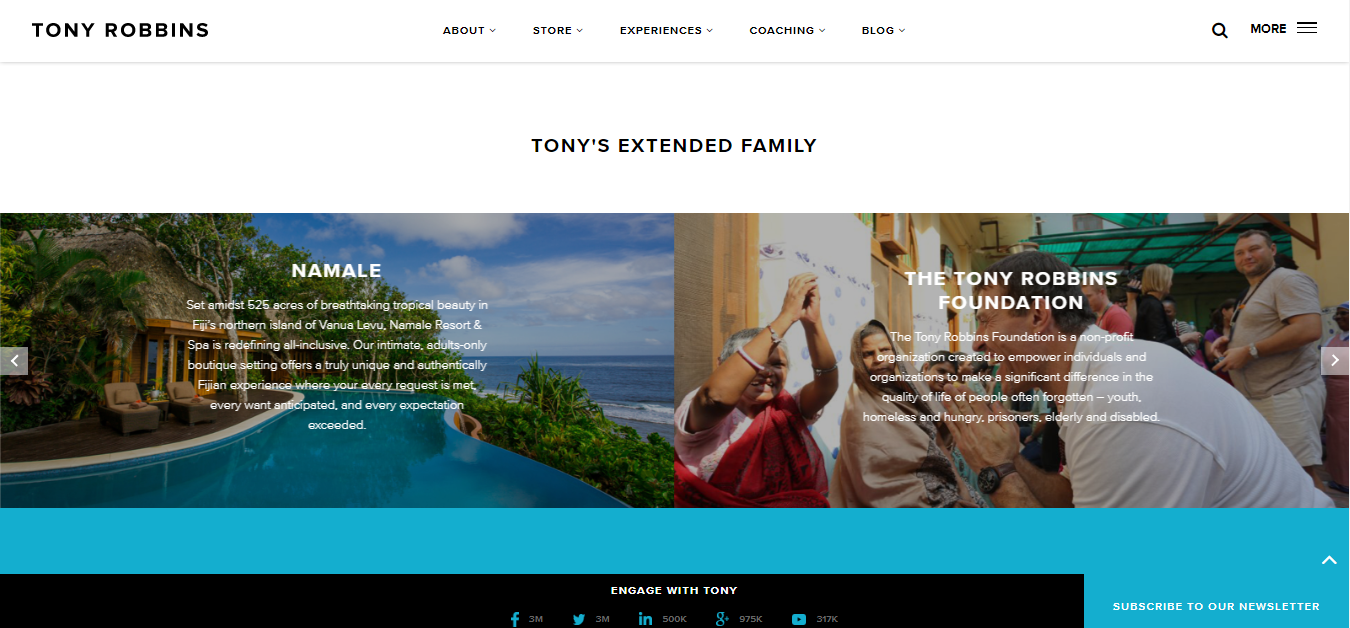
And to finish, “SIGN UP NOW” for the newsletter:
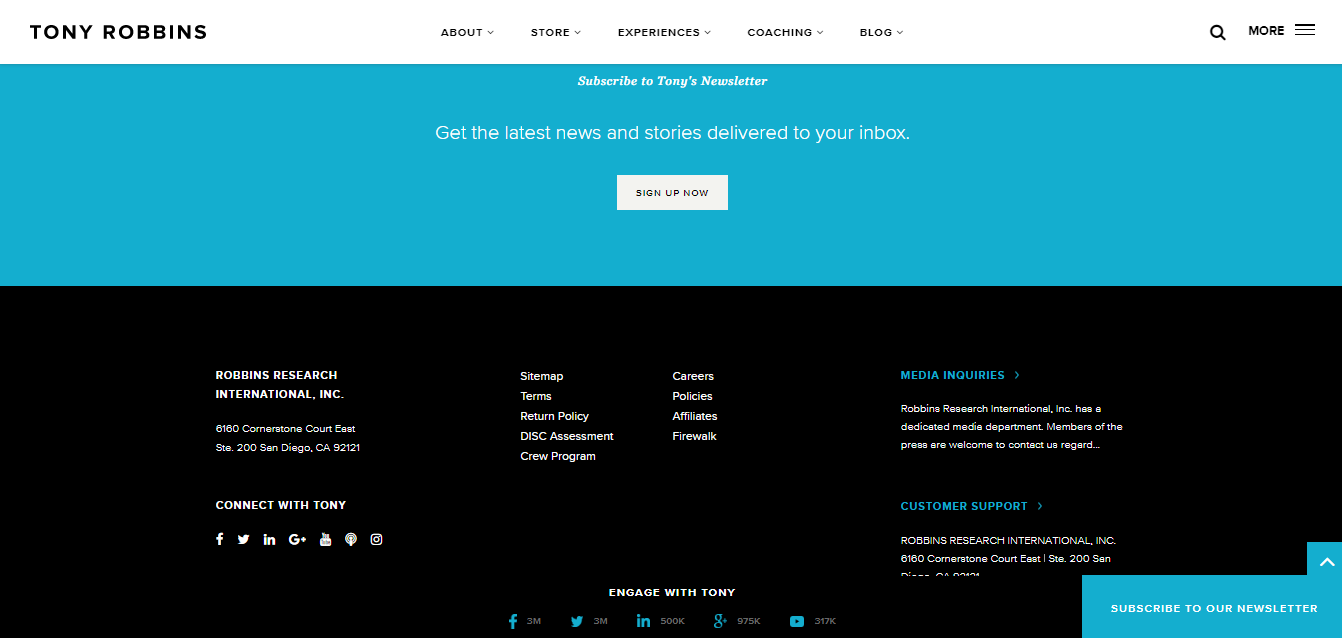
At first glance, this is a pretty overwhelming homepage for the prospect.
And in some ways, it actually might be overkill (after all, do people really need to know about his resort in Fiji before deciding to go to a seminar or sign up for coaching?).
The takeaway: Content is KING! My Mum once told me “everyone has their own learning style” and we can break these down with VAKAD.
People are either
- Visual (pictures and videos)
- Auditory (what they hear)
- Kinesthetic (feeling and doing)
- Auditory Digital (facts and figures) learners so you need to have something that appeals to everyone's learning style, if possible.
Everyone has all four learning styles but most people are dominant in one of them.
Tony is taking my Mum’s advice on his homepage by offering different content mediums to match different peoples learning styles.
Here are specific examples of how you can do it too:
For Visual: show people case studies (Tony uses Pitbull, Hugh Jackman and Maria Menounos) and use videos (Tony uses his TED Talk, Netflix documentary and Super Soul Sunday with Oprah)
For Auditory: give people the option to speak to someone so they can make a buying decision (Tony offers people a complimentary results coaching session)
For Kinesthetic: show people the feeling they will get when making a buying decision (Tony gives people the feeling of luxury from his resort in Fiji and the feeling of altruism from his Tony Robbins Foundation)
For Auditory Digital: present what you do in an organized way so that people can work things out for themselves (Tony does this by segmenting his email list based on his “Wheel of Life” quiz categories and sending them relevant, timely content where they need the most help right now)
[Tip #3] Invisible Mini-Funnels: Get More Sales By Using High Converting Goal-Based Mini-Funnels To Show Your Website Visitors Personalized Product Recommendations
Remember this part of the homepage that I promised we’d talk about in the last tip?

Let’s see what happens when we click one of those “LEARN MORE” buttons.
If I click the button under the ‘business’ category, I end up on a page that lists business goals like “get more clients” and “reduce risk”:
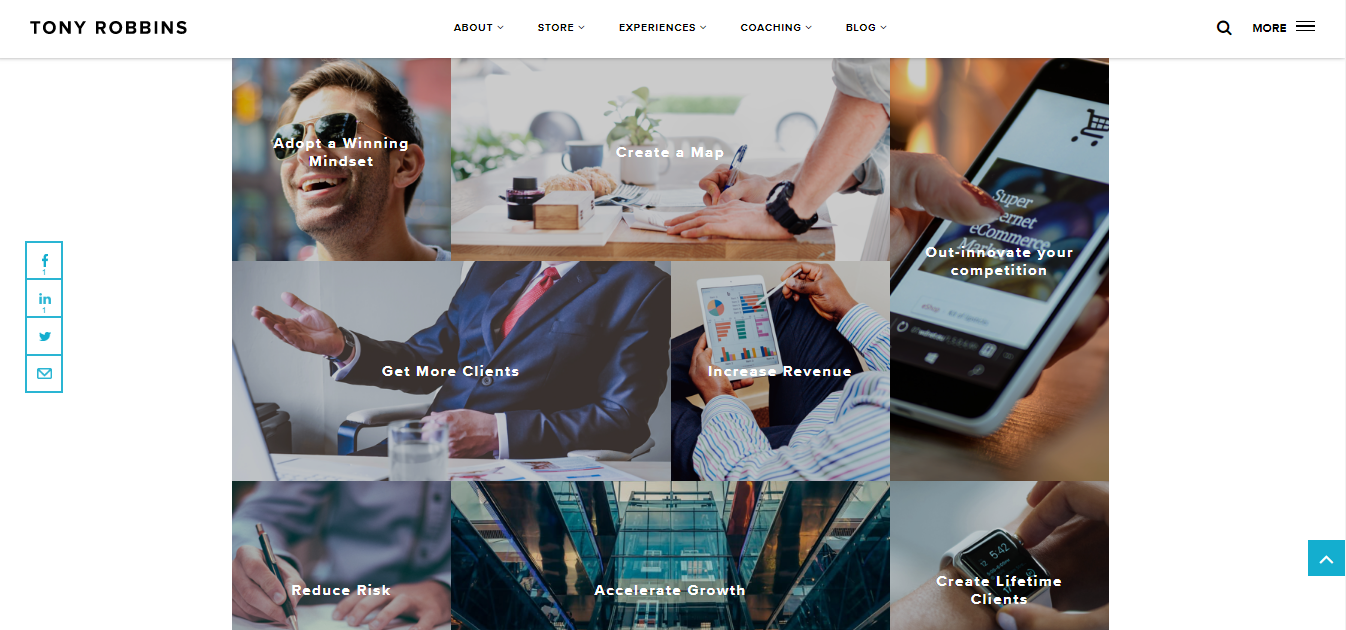
If I click the Increase Revenue image, I end up in Tony’s mini “increase revenue” funnel (that’s even what it’s called in the URL):

If we move down the page, we hit the first offer: “GET A FREE COACHING SESSION"

From there are a couple of CTAs to join one of Tony’s seminars or a business mastery class:
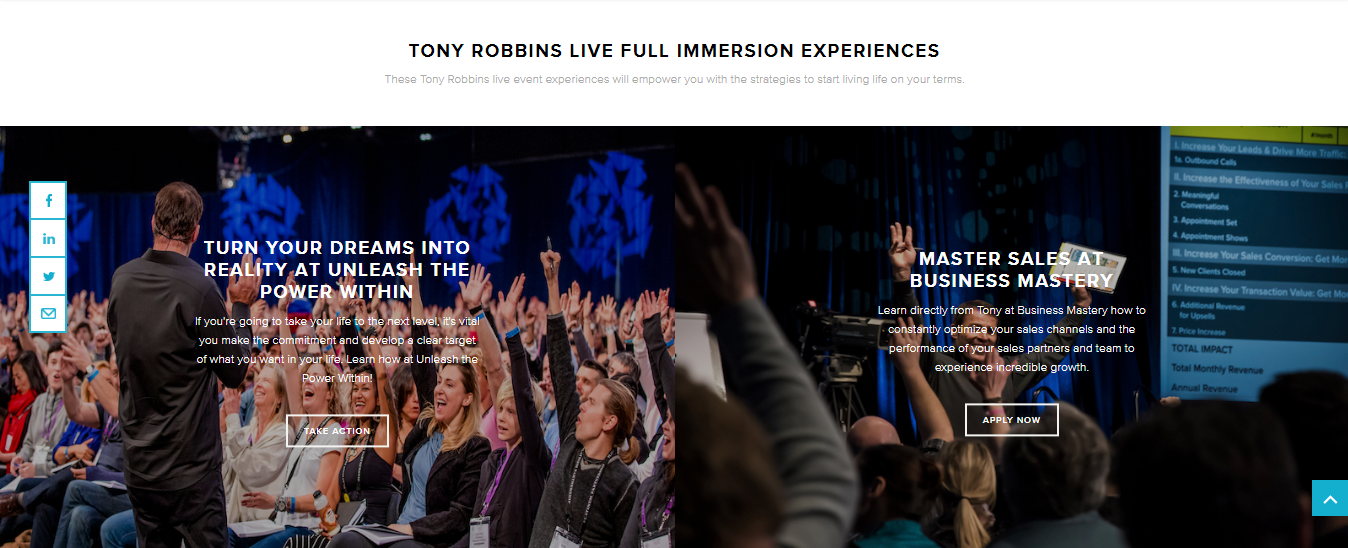
Then, we find a few product offerings that are related to the ‘business goal’ the prospect clicked on (“increase revenue", in this case):
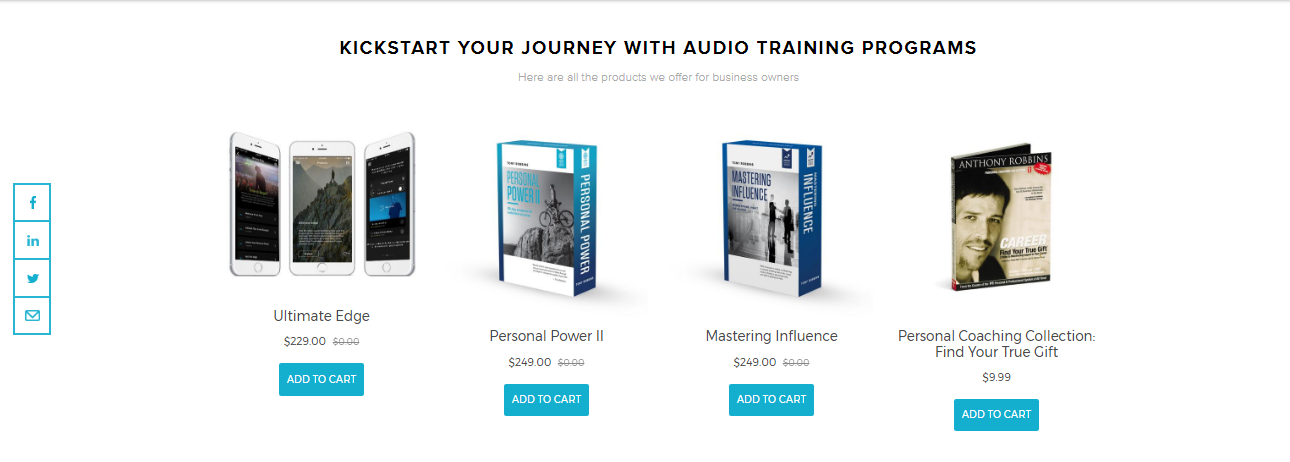
Followed up by a free trial offer:
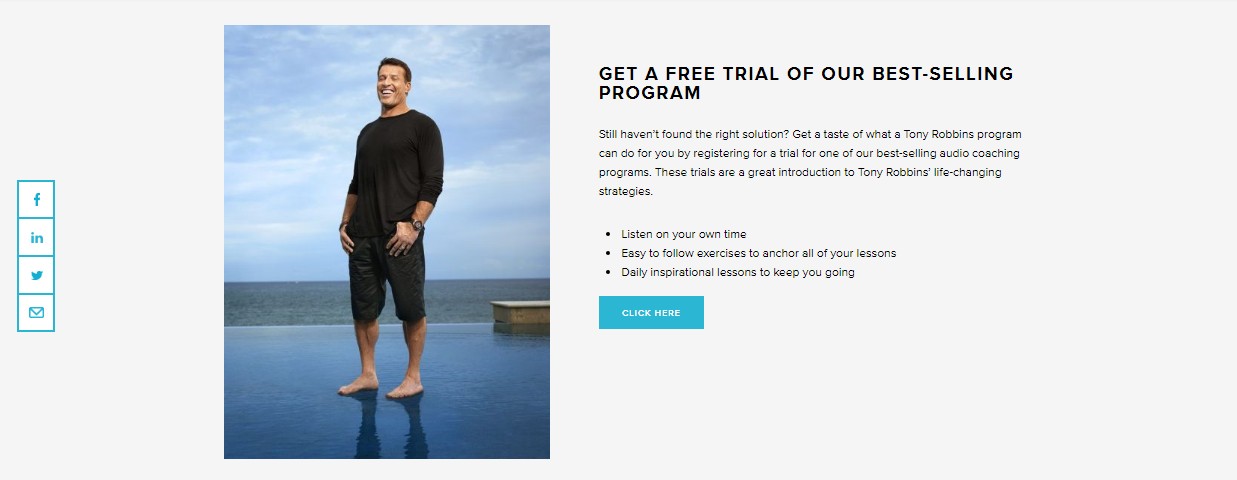
And some blog content that has been specifically tailored to the funnel:

If you backtrack, you’ll find that there’s a special mini-funnel for every single one of these subcategories and goals.
So, if you click on “Maximize Your Health” under the ‘personal life’ subcategory, you end up here:

This health funnel has its own “Unleash The Power Within” headline and mastery class offering:

Its own relevant product offerings:
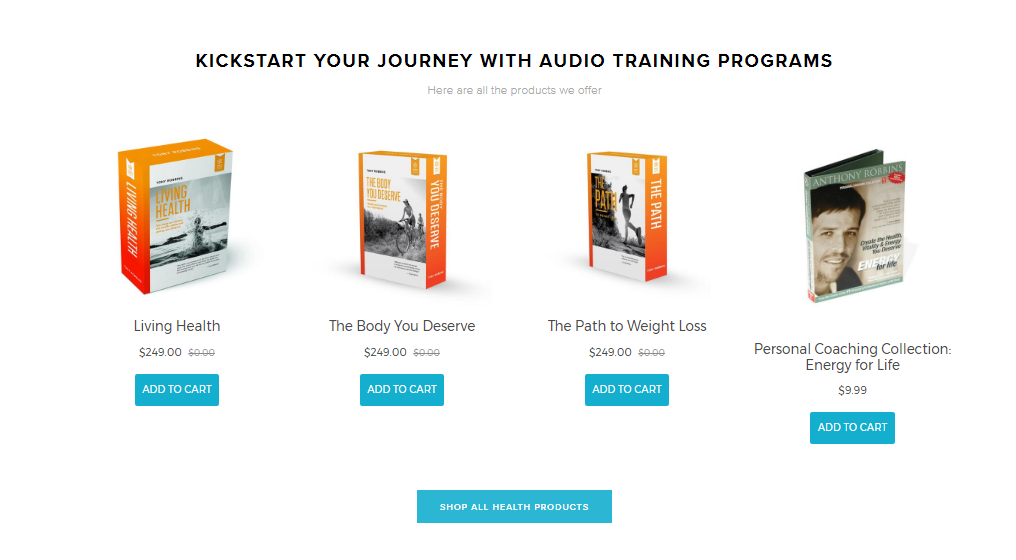
And its own customized blog post offerings (although, this one section could use some work):

There are a few CTAs that stay the same no matter the funnel: the initial coaching call, the ‘Unleash the Power Within’ retreat and the free trial offer.
Although these 3 product offerings are the same across all pages, the prospects will perceive them as different.
Having prospects go through the process of first clicking on the specific category and goal they are interested in achieving makes all the content on the mini-funnel page seem like a customized, personal solution just for them.
The takeaway: Give prospects a way to ‘show’ you what they are interested in and want to work on, then offer up what seems to be a personalized set of solutions (Tony uses 8 business growth mini-funnels and 8 personal growth mini-funnels to try and cover every business and personal life improvement goal people are looking to achieve)
[Tip #4] The Most Unusual Method For Converting PPC Traffic Into Product Sales: “The Top-Level Landing Page Method”
Here’s a look at Tony’s top performing PPC ads:
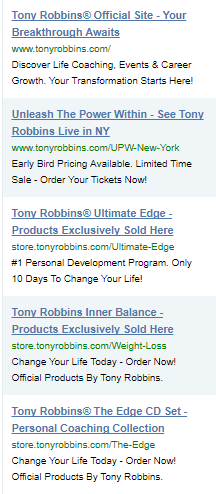
As is fitting for someone whose success is linked to his personal brand, the first word in each ad’s headline is Tony Robbins’ name itself.
The ads also contain a blend of strong CTAs (“Order Now!” and “Change Your Life Today”) and elements of urgency (“Only 10 Days” and “Limited Time Sale”).
But what I really want to talk about are the landing pages that these ads take you to.
A quick Google search for “tony robbins blog” gives you results like this:
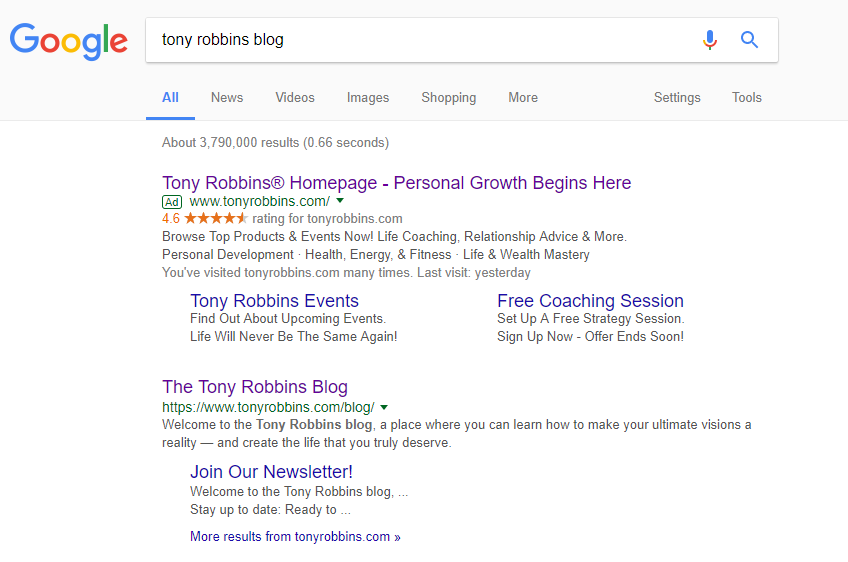
The first result is, obviously, one of Tony’s paid ads. The second is just the top organic search engine result.
But now take a look at the landing pages for each of these search results.
As is expected, the organic search result brings you directly to the blog as per your search intent. But the same isn’t true for the PPC ad. Instead of giving you the direct blog link that you searched for, clicking on the ad will send you to Tony’s homepage.
A similar PPC ad and landing page sequence happens with many of Tony’s other branded keywords. Here is an example of what a paid branded keyword search funnel looks like:
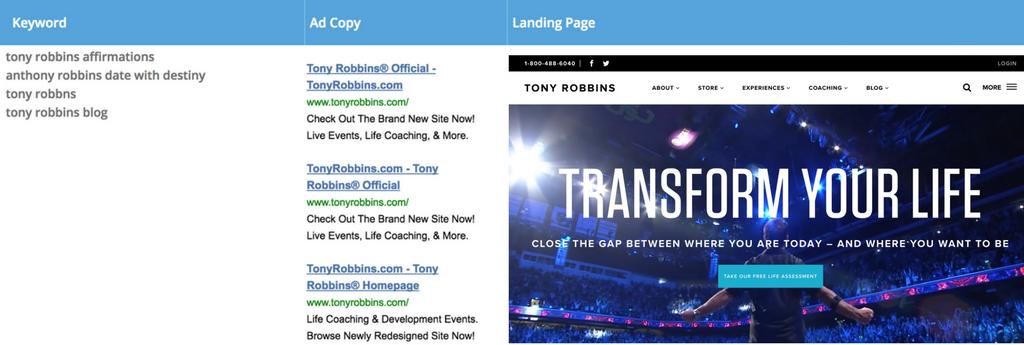
Although most of the branded keywords in the funnel have a very specific search intent, like…
- tony robbins affirmations
- anthony robbins date with destiny
- tony robbins blog
These keywords don’t bring the audience to ultra-specific or highly-relevant landing pages that revolve around the search term.
Instead, all of these search terms bring the prospects to somewhere more general: Tony’s homepage. Why?
Why would Tony do that when Google rewards relevancy with a higher quality score? Why wouldn’t he keep his landing pages highly-relevant to their ad copy and give people a better landing page experience?
Either Tony likes throwing money down the drain while clapping on stage OR he has tested driving traffic to specific landing pages vs top-level landing pages and top-level landing pages get him more conversions.
One thing to remember is the massive amount of awareness the name “Tony Robbins” has.
So if someone is searching with a phrase that includes Tony by name, they are probably interested enough that they’ll seek out their original search intent even if they don’t land on the relevant page (Luckily, Tony’s well-organized menu makes it easy for them to do this).
And, as we’ve seen in our analysis of Tony’s homepage above, it has a lot of good things going for it: it offers plenty of enticing CTAs, social proof and useful free content that gives value to the readers.
Directing prospects to Tony’s general homepage instead of a highly-relevant landing page makes sure prospects get exposed to all that first.
This gives Tony and his team extra opportunities to get leads, promote other products, increase audience interest and build Tony’s credibility for as many visitors to the site as they can.
You see the same technique with Tony’s PPC ads for branded product keywords.
As this paid search funnel shows, instead of directing prospects to the product page for the specific product search, they are directed to Tony’s top-level general Products page which lists everything he sells. No matter what product the prospect actually searched for.
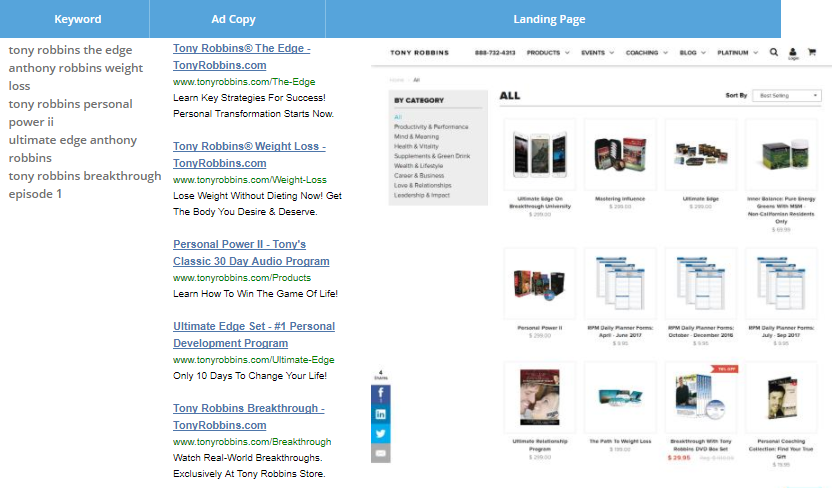
To make sure the viewer can still find what they are looking for, there are categories on the left side of the page for them to navigate through.
Tony also applies this same technique for non-branded keywords.
Here’s Tony’s paid search funnel for the non-branded PPC keyword “time management calendars”:
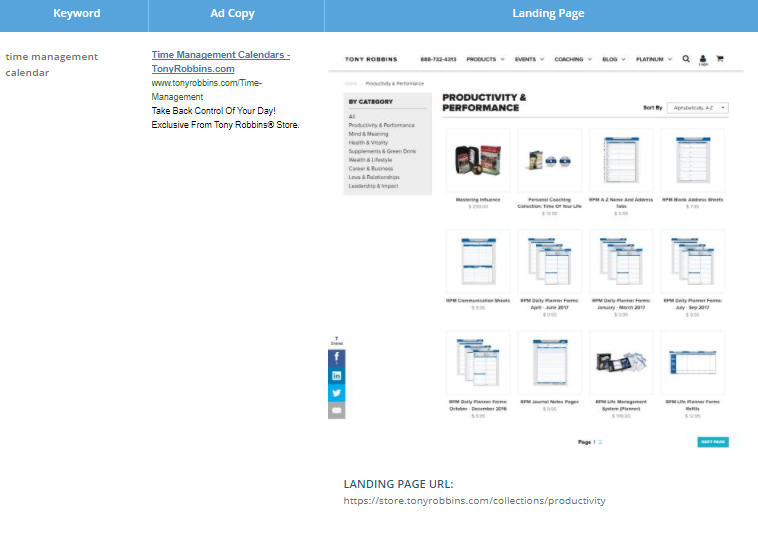
When a viewer clicks this ad, they are sent to Tony’s top-level ‘Productivity & Performance’ product page. This page features not only the time management calendars the prospect was searching for, but also some extra product offerings that fall into the same category (and would likely be of interest to the searcher).
Warning: Implement this tip at your own risk. Tony has a big brand name and this method is unusual. In the end you need to test, that's always the answer in the end.
The takeaway: Test top-level PPC landing pages against specific product-level landing pages to see how you can maximize the amount of offers you put in front of your prospects. Just be very aware of your searcher’s awareness level with your brand and make sure they can still follow-through to their original search intent.
[Tip #5] The Peacock Technique: Display Your Finest Social Media Posts On Different Social Media Platforms To Attract The Attention Of Your Biggest Fans
Although social media was not around back when Tony first got started, today it’s something that factors highly into his marketing strategy.
Today, he has 7.9M followers across his 5 main platforms.

And 17.25% of all his website traffic comes from social media, which adds up to an extra 165,000 visitors monthly.
That’s 1 website visitor for every 47 social media followers.
Here is a breakdown of Tony’s top social media platforms:

So, how did Tony manage to create such an impressive following? Well, the fact that Tony had been well-known and famous for years beforehand certainly helped.
Unlike many other businesses, they don’t just post the same content across all platforms. This article published on Tony’s blog gives us some insight into the type of content they believe do best on each platform.
Let’s look at how each of Tony’s social media platforms match the insights given in the article.
What Tony’s article says:
“Announcements, invitations, photo galleries, videos, and longer-form storytelling work very well on Facebook. Any content immediately interesting and conversation-worthy will keep people coming back.”
What Tony does:
Tony uses Facebook as a platform to announce his upcoming events and promote his videos (both of which are located near the top of the page).
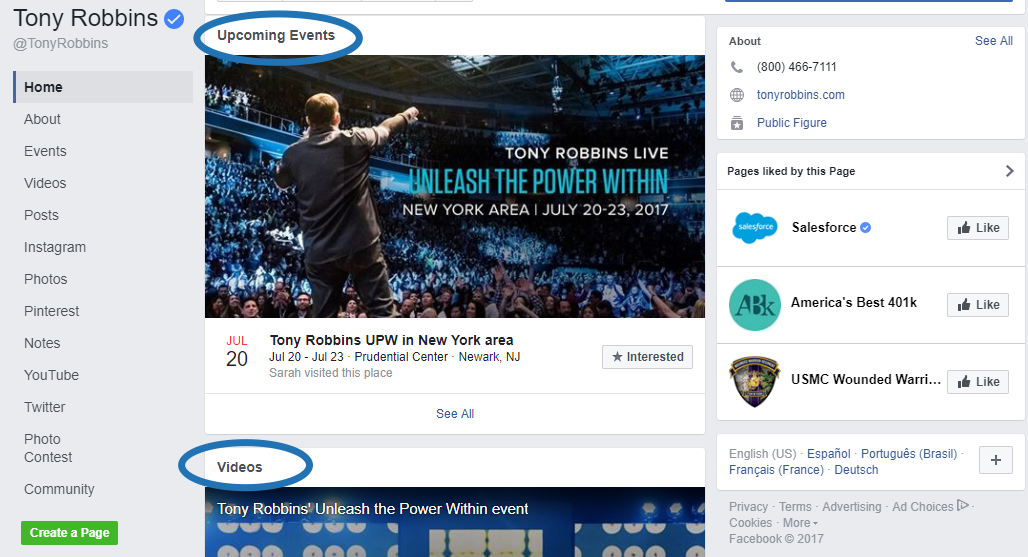
He also uses it as a way to share his blog content and offer up ‘bits of wisdom’ that generate conversation among his followers:
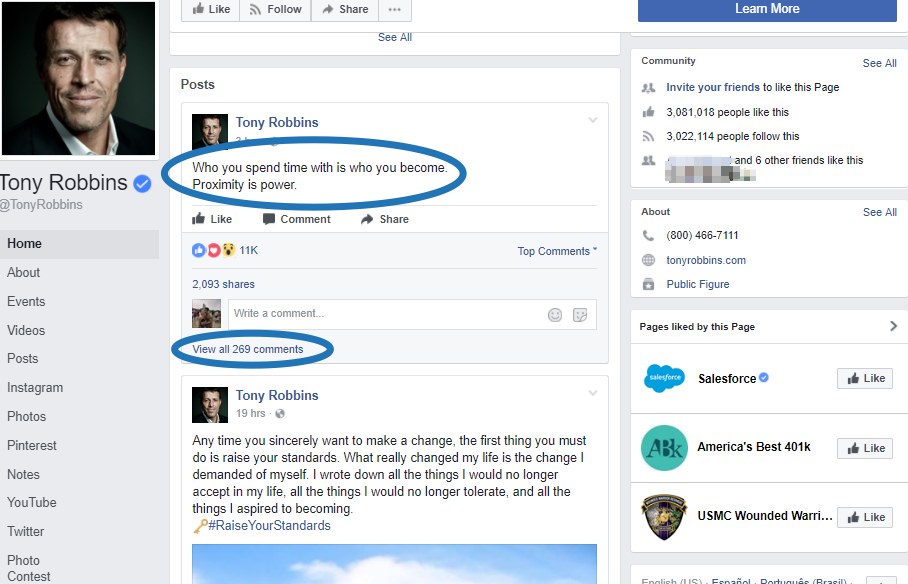
What Tony’s article says:
“LinkedIn is a must for any business, brand or working professional — it’s most powerfully used as continual networking, recruiting and value sharing. Avoid using LinkedIn for content that is excessively personal, or not relevant to a business networking audience.”
What Tony does:
To generate LinkedIn traffic, Tony has the huge benefit of being a LinkedIn Influencer. This lets him publish articles directly on LinkedIn’s platform which exposes them to an extended audience.
Unfortunately, becoming an official LinkedIn Influencer is done on an invitation-only basis. But if you play your cards right, you can still become an LinkedIn influencer in all but the title by publishing thoughtful, long-form content appropriate for the audience.

So of course, that means neither you nor Tony should publish just any type of content on LinkedIn.
Tony stays away from posting about things that are too personal or irrelevant to the business-minded LinkedIn audience (even though he shares that type of content on his other platforms).
What Tony’s article says:
“In the realm of business, Twitter has replaced customer service as a first point-of-contact for both negative and positive experiences….Twitter is key for expanding awareness, special incentive offers and linking to longer-form content that add value.”
What Tony does:
As you can see by Tony’s cover photo, bio and pinned tweet, he definitely uses Twitter as a means of expanding awareness. In this case, for expanding awareness about his new book:

He also builds awareness of his personal brand and of who he is by retweeting content other people have written about him:
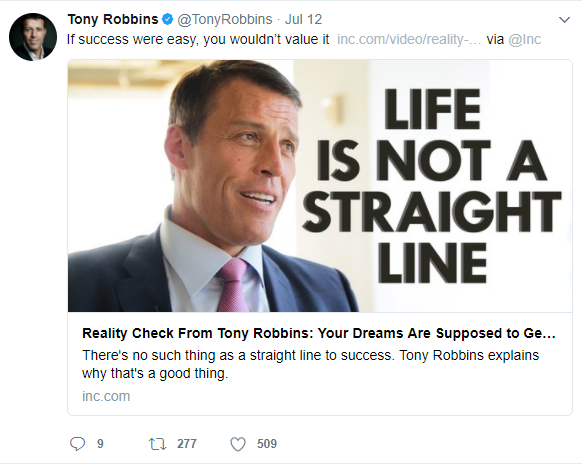
And of course, he gives his followers plenty of 140-character nuggets of wisdom that are just perfect for getting shared around and retweeted with hashtags like #WednesdayWisdom and #ThursdayThoughts:
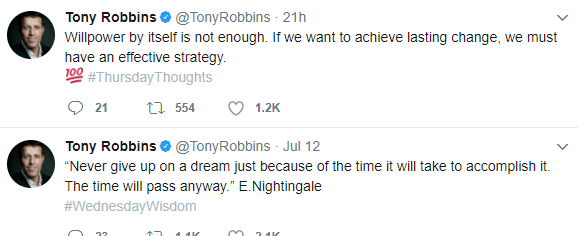
Unlike many companies today, Tony does not actually use Twitter much as a customer service platform.
And here are just two final insights into how Tony’s team approaches social media marketing, courtesy of this interview with Tony Robbins’ marketing director, Tyler Culbertson:
1) When it comes to social media, Tony Robbins and his team are really big into numbers and keeping things measurable. They know that not all their social media followers will convert, so they believe it’s important to try to track which ones are. This helps them see what their social media ROI looks like.
Click here to reveal which tool Tony uses to measure his social media ROI.
2) Tony doesn’t use social media as a way to generate direct sales. Instead, his focus is on brand building and providing his audience with value. In Culbertson’s words at 12:32 in the interview “you’ll never see Tony Robbins selling from his social media networks.”
The takeaway: Don’t get lazy and just spread the same content across all your social media platforms because it’s easy. Use the 2-step peacock technique:
Step 1) Research what type of content performs best on the platforms you use (using this article)
Step 2) Adjust your social posts to match the social media psychology of people on each platform
[Tip #6] Follow Tony’s TRRCSS Sales Call Strategy To Close More Sales With This Simple 5-Step Shortcut
In a time when calls seem to take up a smaller and smaller slice of customer communication, Tony and his team stick out in the way they prioritize calls.
You can see this by all the variations of the “schedule a call” or “speak to someone” CTA found again and again throughout the website.
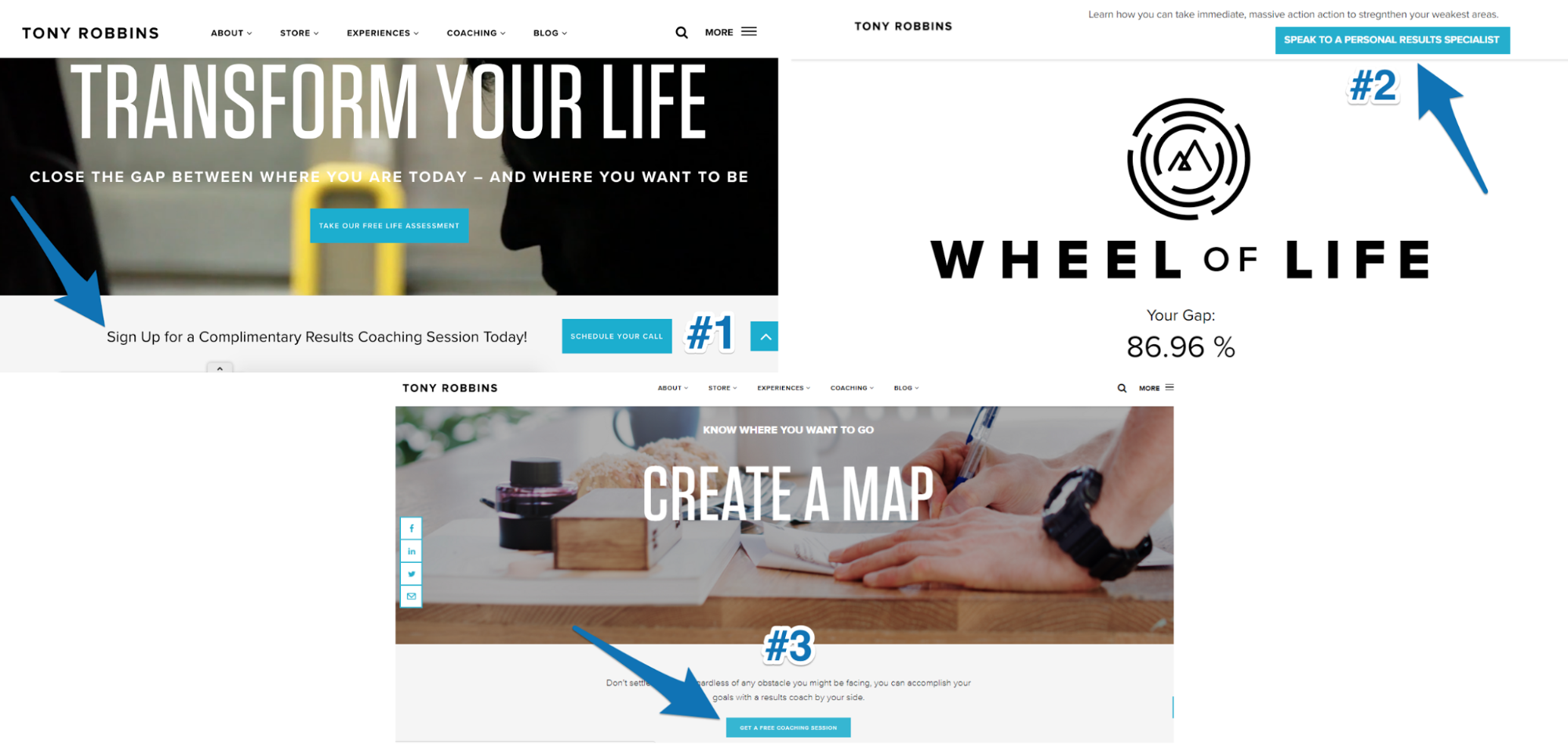
#1 – It’s CTA #2 on the homepage.
#2 – It’s the CTA given after prospects finish the life assessment quiz on the homepage.
#3 – It’s the main CTA for those mini-funnels we talked about in tip #3.
In other words, Tony’s team really wants to get you on a call. Which means they continue to find that getting someone on a call is a very effective way to close a sale.
To see what sort of sales pitches they were using on these phone calls, I signed up for one of the free coaching calls myself.
What I was surprised to find was that they weren’t the usual sort of ‘pushy’ experiences generally associated with sales calls.
This is an overview of how the call went:
1) After I had scheduled my appointment, I received an email that introduced me to my coach and gave me two pieces of “homework” to complete before the call:
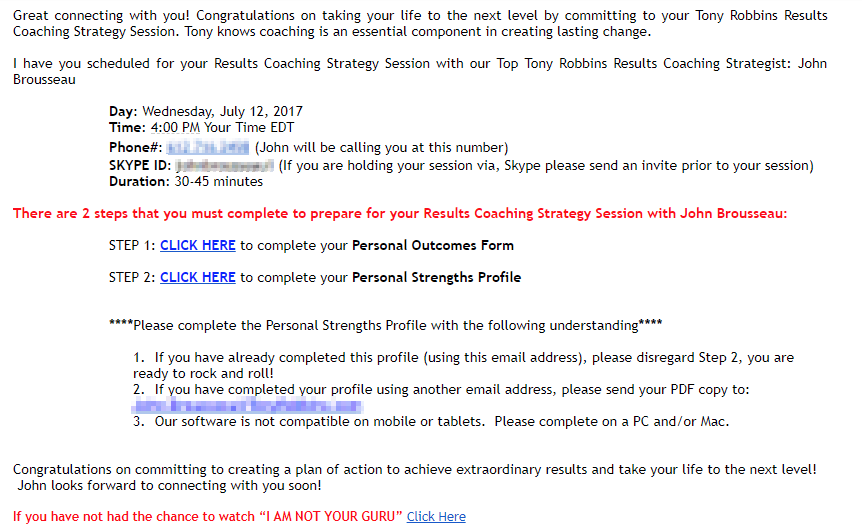
Clicking on STEP 1 brought me to a page all about the guy I was going to speak with on my call:
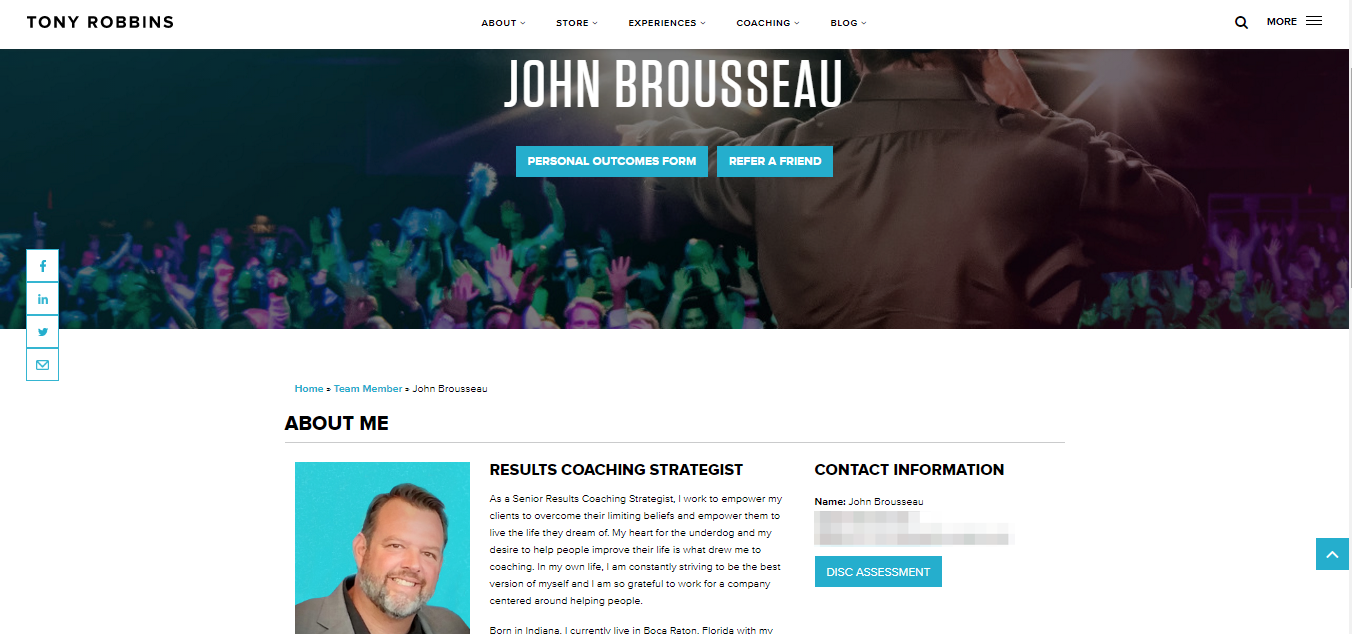
Clicking on the “PERSONAL OUTCOMES FORM” brought me to a short questionnaire that asked some general personal info plus my goals, what I was struggling with and what I hoped to get from the call:
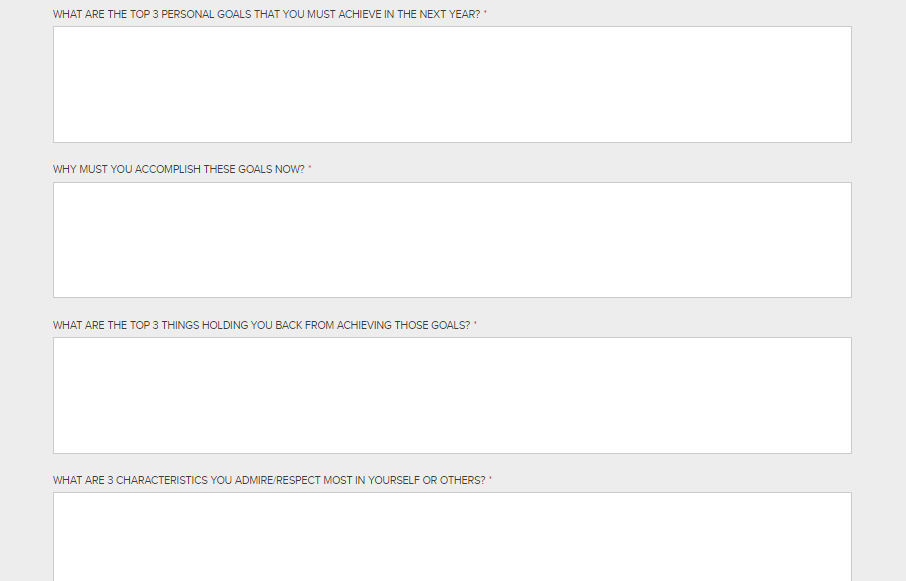
Once I finished this, I went back and clicked on STEP 2 in the email. It directed me to Tony Robbins’ famous DISC personality test:
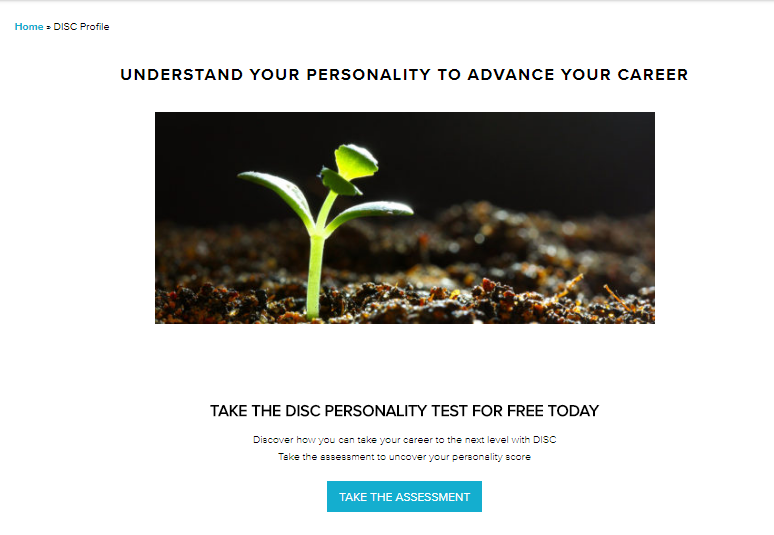
Having prospects go ahead and fill out this type of info before a call is a double-whammy pre-sales tactic: first, it builds up the prospect’s anticipation and interest, makes them think critically on what they need a solution for and essentially “softens them up” to accepting change (aka your service).
Second, it gives the coach a direct insight into the prospect’s weak points and overall personality. This helps them tailor the call in a way that provides the prospect with value, yet also makes them more likely to convert.
2) The call itself began with a friendly greeting and just a few general questions about who I was, where I lived, etc. The coach then told me a bit about himself (this was him trying to build up a connection and trust with me, his audience member).
3) We then moved on to talk about and verify some of the things I had put into my pre-call questionnaire and personality test.
4) After he got more big-picture specifics, we chose a single issue I had brought up and dug deeper into it (in this case, it was finding work/life balance).
We discussed why I thought it was an issue and he offered up some suggestions that were actually useful and actionable. (In other words, the coach made sure I got some value from the call).
5) Now came the sales pitch (though it wasn’t a sales pitch in the usual sense). He asked what I knew about Tony Robbins and his coaching, then gave me a general overview of the program. Though it wasn’t pushy at all, something that caught my attention was how the coach gave me very specific examples of how the coaching would help me with the specific problems we had talked about on the call.
This is a good sales tactic for a few major reasons:
- It makes prospects feel like they are listened to (which makes you more trustworthy and likeable)
- It makes the service seem like a customized solution just for you
- It helps prospects visualize how the service could fit into their lives
The call ended without any sort of final selling attempts, and I was told I could contact the guy anytime if I wanted to go forth and sign up.
The takeaway: Get your website visitors on the phone whenever possible. Once you’re on the phone with them communicate in a way that gives them value based on their individual goals (and doesn’t just sound like a script with an irritating sales pitch at the end).
[Tip #7] New 3-Part Dynamic Carousel Retargeting Ads That Avoid Banner Blindness And Generate Dirt Cheap Clicks By Showing Social Proof To Get More Clicks From Your Ad To Your Product Page
If there’s one thing Tony understands, it’s the power of repeated marketing touches and social proof to make his sales effortless.
And one way Tony nails this is with an aggressive retargeting technique.
Since I’ve begun my research several weeks ago and first ended up on Tony’s website, I’ve had a NON-STOP onslaught of Tony Robbins ads across all sorts of platforms.
Now, obviously, retargeting is super effective or else Tony wouldn’t be bothering with it as much as he is.
The benefit of retargeting ads is that they work to nurture people who’ve already shown interest in your website by visiting it. Naturally, it’s much easier to convert these ‘warm’ leads than to convert 100% cold prospects who are oblivious to your product offerings.
Here is Tony’s 3-part Dynamic Carousel Retargeting ad I stumbled upon on the Google Display Network:
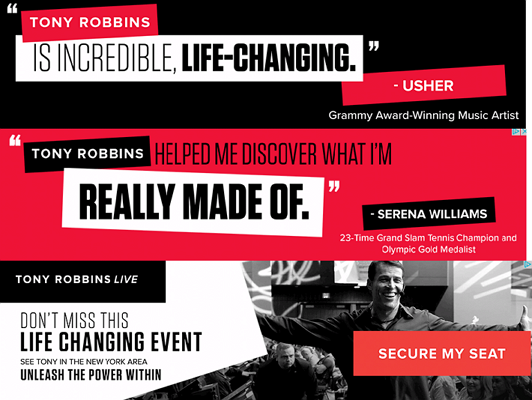
With all the retargeting Tony does, one thing he has to be very careful about is “banner blindness.” This happens when people get sick of seeing the same ads over and over again to the point that they no longer notice them.
This results in “ad fatigue” where the click-through rate on your ads start to decrease, and your cost per click starts to increase. #badnews
Luckily, there’s an easy fix to this: change one element of the ad.
As you can see in the banner ad below (which I found about 2 weeks after that pink and black one), the element Tony changed was color. It was an easy fix (since most of the text is the same), but one that definitely made me stop being “blind” to Tony’s ads and notice them once again:
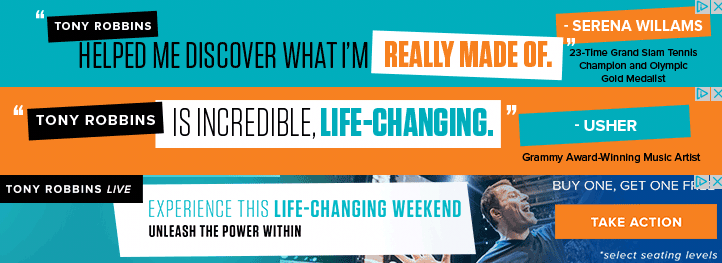
Tony makes these 3 banner ads work together by turning them into one dynamic ad that rotates quickly through. So, if I come across one of Tony’s display ads anywhere, they cycle through (as in, it’s a single ad that flashes through all 3 images).

Making these images cycle through not only catches the eye more than a static ad, but it lets Tony use social proof to back up why prospects should click through to his product page (increasing his click-through rate and lowering his click costs).
The first two banner ads use social proof to build trust before using strong, urgent language (either “don’t miss this life changing event” or “experience this life changing weekend”) to get people to take action and click.
Even though the 3 ads may look different, they all work together to direct people to one place: a landing page for Tony’s “Unleash Your Power Within” event.
Here’s what the landing page looks like:
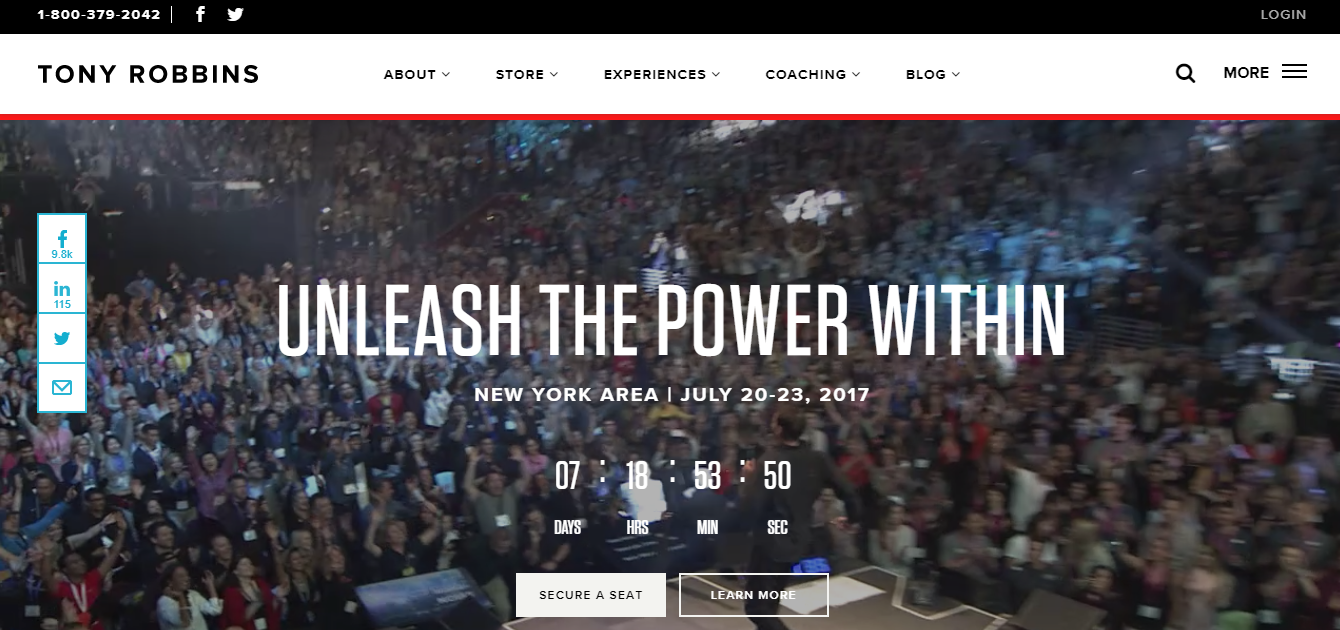
In addition to GDN ads, Tony is also investing heavily in Facebook retargeting ads:

And you’ll even find his ads (for that very same “Unleash the Power Within” event) on YouTube:
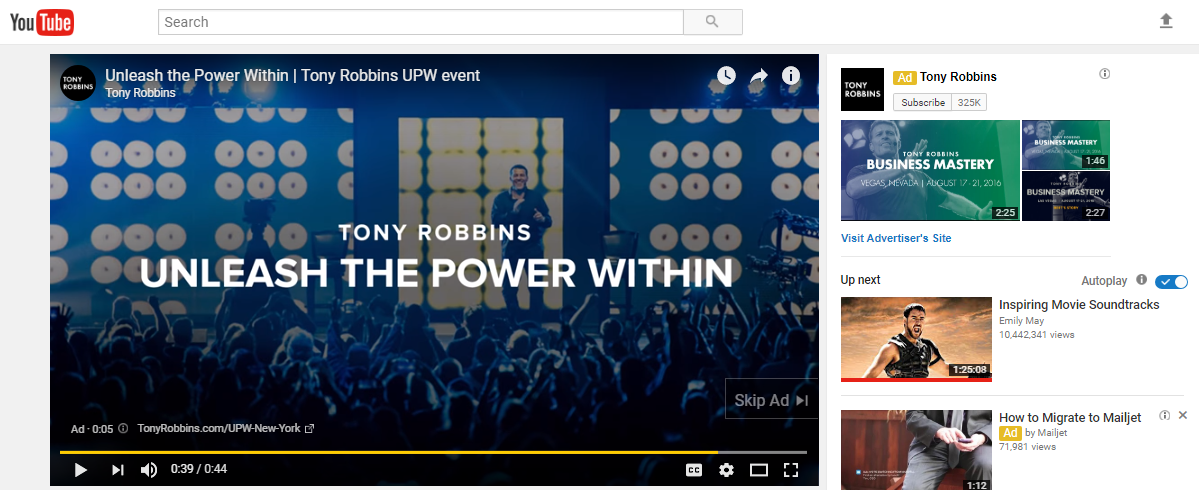
Tony is leveraging retargeting everywhere he can to drive more people to his next big event at cost-efficient scale.
The takeaway: The secret to maximizing your product sales is with extensive retargeting and a simple sales funnel. You gotta leverage your inbound traffic by thinking bigger with your retargeting.
Not bigger in terms of less qualified people, mass pixeling or higher banner ad frequency.
Bigger in terms of blanketing the web. When you leverage your inbound website traffic and are everywhere it creates a whole new effect that makes small budgets work like big budgets (Tony retargets his website traffic across the Google Display Network, Facebook and YouTube to his next upcoming event).
[Tip #8] The Tony Robbins Clapping Ritual: 7 Insane Rituals To Create The Most Exciting Weekend Ever For Your Event Guests
Tony is one of the best live event prepper’s in the world.
People pay good money to attend Tony’s events (for “Unleash The Power Within” the price is anywhere from $650 to $2,995) and Tony is expected to deliver EVERY time.
To see exactly how Tony delivers high-performance events for his guests I got my buddy Barron Cruz from Charisma Matrix to reverse engineer his whole 7-step pre-event ritual:
%(youtube)
Here is exactly what Tony does to get pumped up:
- Meditation
- 57° Fahrenheit cold plunge
- Warms up his voice
- Shoots liquid supplements into his mouth (we speculate Ginseng)
- Jumps on a mini-trampoline
- Does a classic MC Hammer spin followed by a chest pump
- Tony Robbins clapping ritual (watch the video to see what I mean)
The takeaway: High-performance athletes have a ritual to guarantee they are always performing at their best. If you want to create the most exciting event ever for your event guests, get your own pre-event ritual.
[Tip #9] Use One Of Tony’s 3 Successful Podcast Types To Take Your Podcast Category Ranking To The Top Of iTunes
The Tony Robbins podcast has played a major part in Tony’s content marketing strategy. It’s even done well enough to claim 2nd place for education podcasts in iTunes (behind TEDTalks):
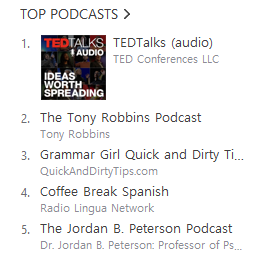
Tony’s podcast episodes fall loosely into 3 main categories:
Podcast Type #1: Guest Interviews with Experts
The majority of Tony’s podcast episodes are ‘Type #1s.’ They provide interesting, insightful interviews about topics relevant to Tony’s audience (usually being something that fits into one of the 7 categories from his ‘Wheel of Life’ quiz and blog post categories).
Their purpose is to give his listeners free, “no strings attached” value and information. This is why, within these types of podcast episodes, you won’t find a single CTA directing you towards Tony’s product offerings.
Interestingly enough, these interviews aren’t actually hosted by Tony at all. (Which is probably something he can get away with simply because his brand is already so big.)
Here is an example from the ‘Health & Vitality’ category: A New Approach to Wellness interview with Chris Kresser
Podcast Type #2:
Tony Monologues
These types of podcast episodes feature Tony and Tony alone. In them, he discusses a topic in depth.
He seems to use these Tony-only podcasts when he wants to promote a specific upcoming event. In this case, he brings up the event briefly both before and after the main episode content. At the very end, he gives listeners a link they can head to for more info.
Here is an example where Tony repurposes his super-famous TED talk to grow his podcast: Why We Do What We Do
Podcast Type #3: Behind-the-Scenes Event Excerpts
These types of podcasts are just audio excerpts from one of Tony’s events with a short intro and conclusion by the host. Tony’s most popular type #3 podcast episode was an audio clip of him coaching an audience member right on stage during his Date with Destiny event.
This is a pretty smooth way of promoting his events – not only does Tony include enough audio in the podcast that the listener can feel like they learned something, but offering this little event ‘teaser’ is enough to make a listener curious to learn more about coming to his next event.
Here is an example from Tony’s Date with Destiny event: A Look Inside Date with Destiny
The takeaway: Be known for something (Tony is known for his guest interviews, life improvement tips and behind-the-scenes event excerpts). Keep some variety in your podcast episodes but have a common theme (Tony’s overarching theme is “life advice”).
Don’t overload your podcast episodes with too much promotional material. Give your listeners helpful, high quality content and find smooth, relevant ways to mix in your product offerings (Tony uses his event excerpt content as a natural way to promote his events).
[Tip #10] The Content Multiplier Technique You Can Use To Double The Traffic You Get For Every Article
On its own, Tony gets impressive viewership and engagement on his blog.
As in, enough viewership and engagement that his top 4 articles average out to 20k shares per article:
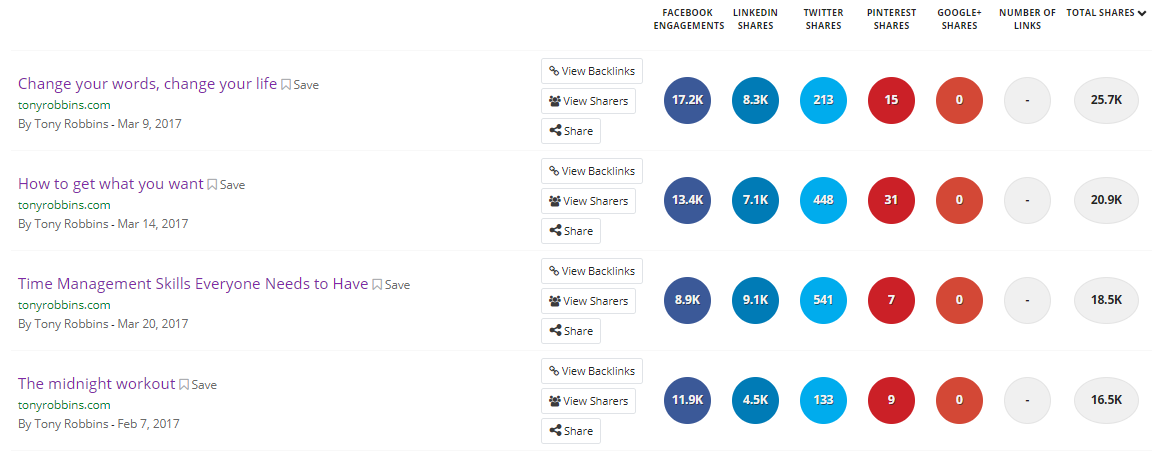
But on top of the blog Tony has on his website, Tony has also set up plenty of other content sources that let him reach out beyond his usual audience.
These include:
- As a guest writer on Entrepreneur.com
- As a contributor to Arianna Huffington’s Medium publication, Thrive Global
- As an exclusive influencer on LinkedIn
Sometimes, the content he creates for the above sources is 100% original and won’t be found on either his blog or elsewhere. This makes sense as the type of content that performs best on each of these platforms will vary, so just because it’s performed well on one platform won’t necessarily translate to success in another platform.
But in some cases, he takes advantage of the articles that he knows have already performed well and then repurposes them to put up on another one of these websites.
This is exactly what Tony does for his #1 article in the table above. Here is Tony’s top article on his website: Change Your Words, Change Your Life

He then repurposed this same article for LinkedIn with a slightly updated headline that would better capture the attention of a typical LinkedIn user:
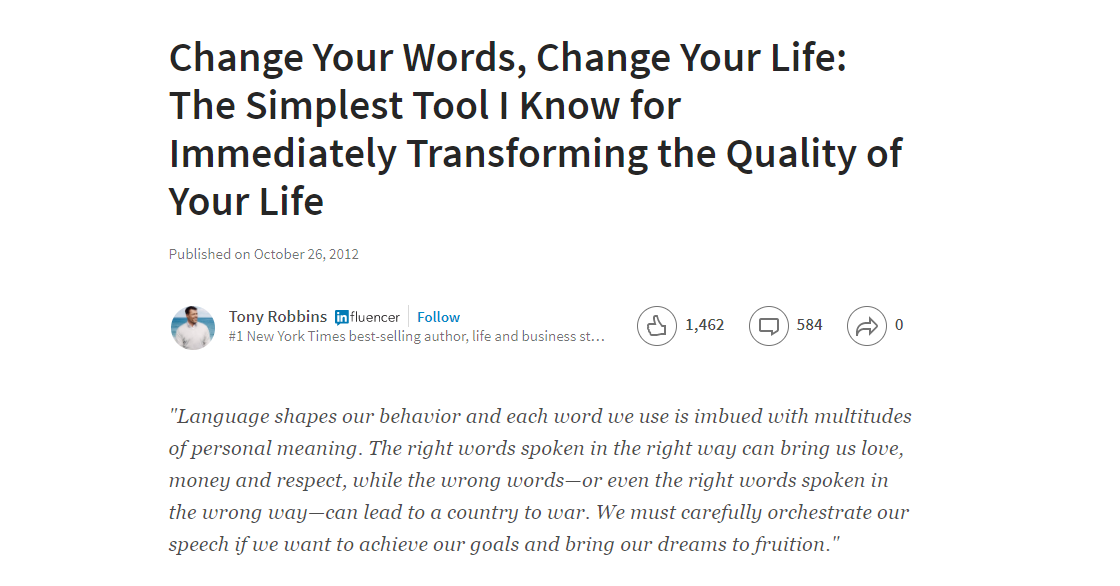
The takeaway: Use the content multiplier method to re-purpose and tailor your content for specific platforms so you can get your content in front of as many eyeballs as possible (Tony does this by being a contributor on Entrepreneur.com, Arianna Huffington’s Medium publication and LinkedIn).
[Tip #11] New Product Pre-Sell Strategy: Use A Welcome Mat To Collect Thousands Of Pre-Orders For Your New Products Without Changing Your Homepage Design
See this:

This is the EXACT strategy Tony Robbins is using to pre-sell new products he releases on TonyRobbins.com.
It’s called a Welcome Mat (a section of the page that first shows when a new visitor comes to the website, then disappears when the visitor scrolls down to reveal your normal page) #superstealth
Tony uses a welcome mat to quickly collect sales for new products without having to change anything on his home page and get tech geeks involved.
He simply turns it on and off as he has new products he wants to feature on his website.
Keenan Shaw (Tony Robbins’ Demand Generation Manager) said this tool helped increase their website leads by 15%.
Click here to see which free tool Tony uses to create his Welcome Mats.
The takeaway: Leverage the latest website technology to improve your website conversions (Tony does this by using a Welcome Mat to pre-sell his new books and other new products he releases).
11 Key Takeaways From Tony Robbins' Multi-Million Dollar Marketing Strategy
Tony Robbins is a big player in the professional training world, but you don’t need a sumo-sized marketing team or budget to get similar results.
You just need a smart Sumo marketing plan.
Here are the 11 key takeaways you can borrow, modify and adopt for your own business based on Tony Robbins real-life marketing tactics:
- Starting off your funnel with a lead gen quiz that follows the AIDA (Attention, Interest, Desire, Action) formula is a powerful way to capture lead info and segment prospects into specific email automation sequences based on their response.
- Using multiple CTAs isn’t always a recipe for disaster as long as most of them are low-commitment, offer a LOT of useful free content and appeal to a wide range of learning styles (like Tony did by offering videos for the visual learners, complimentary phone calls for the auditory learners, etc.).
- People love thinking things were made just for them and your prospects are no exception. Find a way to get your prospects to “show” you what they are interested in and then give them their very own mini-funnel of customized product solutions.
- In Tony’s case, it seems that top-level PPC landing pages perform better than product-level landing pages. Though this is a very unusual (and risky) move for most businesses, it could be something worth testing.
- Spreading all your content on all your social media channels won’t necessarily help you. When it comes to social media, think like a peacock and figure out what type of content spreads best on each social channel.
- Nobody likes a sleazy car salesmen (get your prospect on a phone call and follow Tony’s simple goal-based sales call strategy to get more client enrollments for your business).
- Retargeting doesn’t have to be crazy expensive or crazy complicated. Making yourself everywhere by retargeting across multiple platforms with a simple sales funnel makes small budgets work like big budgets.
- If you do live events, you better get your Tony Robbins clapping ritual and MC hammer spin on point. High-energy events that command your audience’s attention need a presenter who is going to control the room. Great speakers have rituals that pump them and the audience up.
- Podcasts are a super effective way to generate more awareness and traffic for you or your website if you offer listeners lots of interesting, high quality and helpful content. But don’t just jump in like a newb, decide what you’re going to be known for and only slip in your promotional material when it can be done smoothly and naturally.
- The more people that are exposed to your content, the better. Use the content multiplier method Tony uses to help you spread, re-purpose, and customize your content across different platforms.
- There is always new technology coming out that can help you get more website conversions.
Click here to see the tools Tony is using to grow his business.

Win a Free Tony Robbins Book + Course (Valued at $268.95)
Share this post today before our giveaway ends to win:
-> Tony’s #1 New York Times Bestselling book “Unshakeable: Your Financial Freedom Playbook”
-> Tony's #1 Bestselling program “Ultimate Edge”
Related Articles
%(relatedarticles)
Add A Comment
VIEW THE COMMENTS